As Brunswick County booms, here's how massive growth could make it the area's major player
Bill Sue sits in a rocking chair on the front porch of his home on Sue Circle in Leland, pointing out which of the nearby homes he built.
Sue, a Brunswick County native, developed the subdivision in 1969. Back then, there were few paved roads, and much of the area was swamp. With the help of a few friends, Sue cleared areas for a road and drained the land by digging holes and dropping in some dynamite to create a culvert — a practice he acknowledged wouldn’t be acceptable by today’s standards.
“You couldn’t do that today,” he said. “They would put you under the jailhouse.”
But things were different then. Brunswick County had yet to be discovered. Most of the homes consisted of family farms situated on hundreds of acres of land, and development was scarce.
Brunswick County today is a stark contrast to the place recalled in Sue’s childhood memories. Now, cars zoom through the diverging diamond on Village Road in Leland, U.S. 17 is lined with shopping centers and housing developments, drivers face bumper-to-bumper traffic in Shallotte, and shoppers bustle around Howe Street in Southport year-round. Developers are even eyeing the rural community of Ash for their next housing projects.
According to the Blueprint Brunswick 2040, a planning document used by county staff and officials, Brunswick has seen an 85 percent increase in its population over the past 20 years, making it the fastest-growing county in the state and the fourth-fastest-growing county in the nation.
Brunswick is outpacing New Hanover County when it comes to growth, leaving some to wonder if it could one day outgrow its northern neighbor. Though it could be a while before that happens, it’s not outside the realm of possibility.
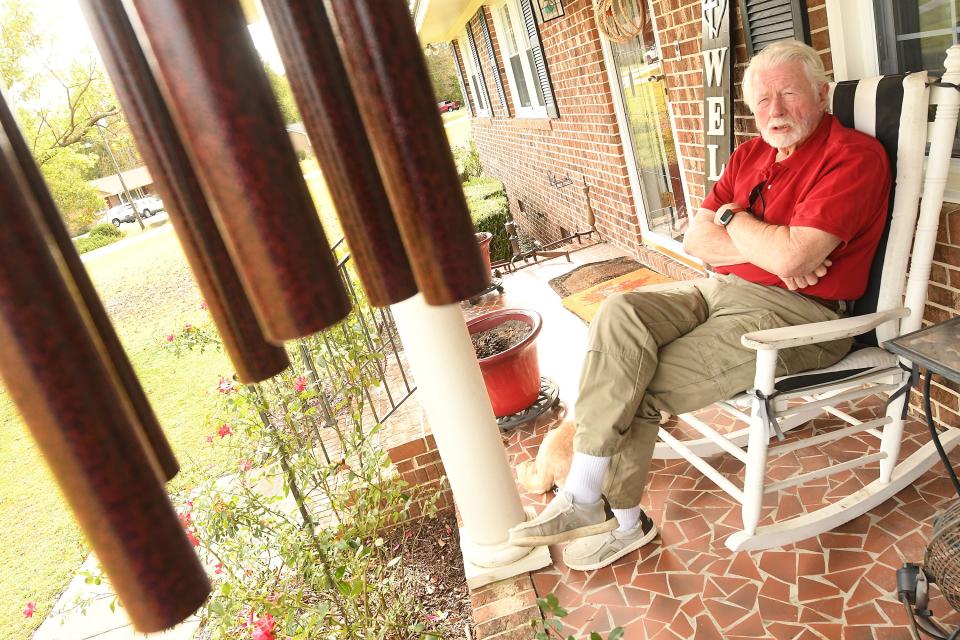
A land of ‘fishing and farming’
For those who want information about Brunswick County, Sue is one of the go-to sources. A Brunswick County native, he served on the Brunswick County Board of Education in the late 1970s and early 1980s and was a Brunswick County commissioner for 18 years. He can still recall when the different developments were built and what was there before the land was cleared.
“When I was a kid, all this was woods,” he said, gesturing at the surrounding subdivision.
At that time, he said there were only two paved roads nearby: U.S. 17 and U.S. 74/76. At the time, the highways were flanked by trees and forestland — not development.
“Nothing was paved,” he said. “And the way I traveled was horseback, bicycle, horse and wagon or mule and wagon.”
Sue grew up in the area that is now Leland, but in the 1940s and 1950s, life in Brunswick County was much different. People didn’t just cruise across the bridge for a bite to eat.
“The first time I ever went to Wilmington, I went on a steam locomotive,” he recalled.
Sue remembered there were stops in several of the smaller towns: Leland, Delco, Lake Waccamaw, and Hallsboro. It wasn’t a journey he made often.
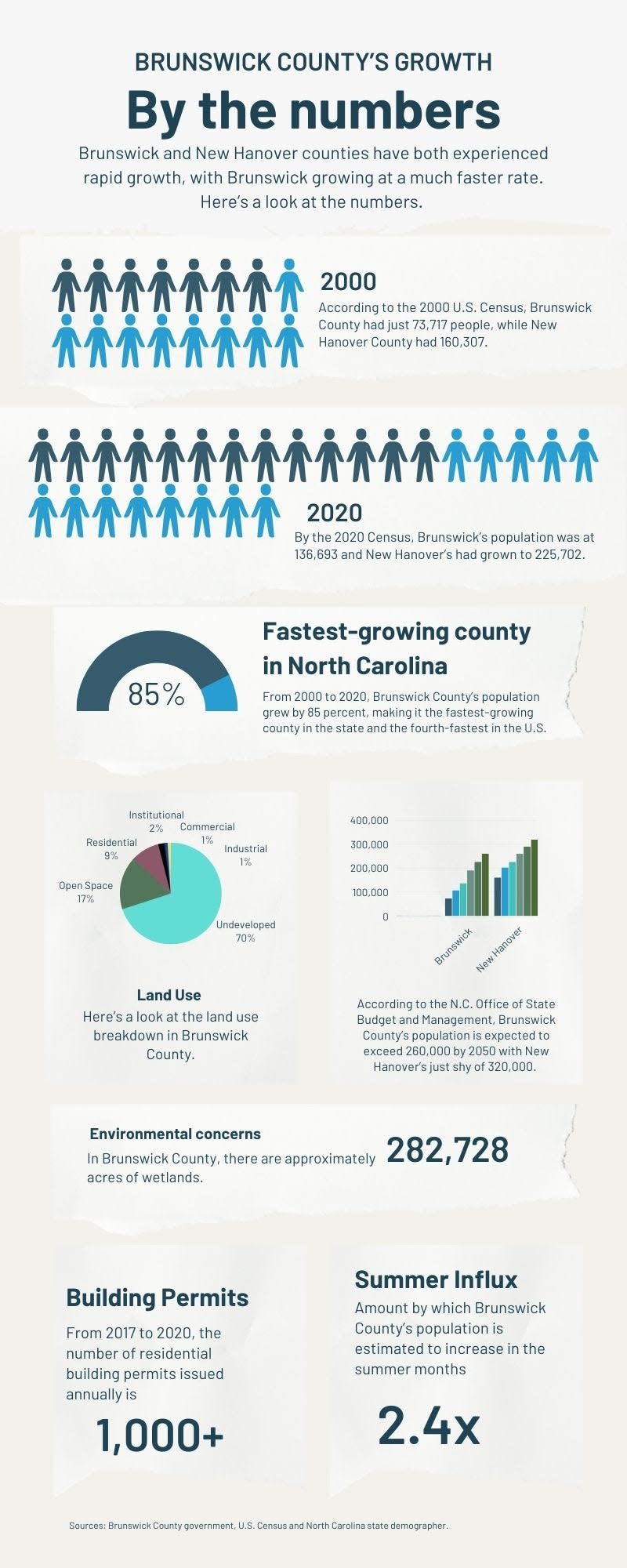
“That was a long trip,” he said, with a chuckle.
Trips to Wilmington were limited to the once-a-year school shopping trip.
“My mother would take us one time before school to buy us three shirts, three pairs of underwear, three pairs of pants and a pair of shoes, and that’s what we’d wear to school and everywhere else,” Sue said. “In the summertime, she’d cut the legs out of them, and that’s what we wore in the summertime.”
The local industries, farming and fishing, provided families with the food they needed: They grew vegetables in large gardens, and raised chickens, cows and hogs.
“Brunswick was a very poor county,” Sue said.
Sue went away to attend college at N.C. State and worked in other states for several years but returned to Brunswick County where he settled in the Leland area. Not long after he returned, he began working to improve conditions for the county’s residents. In the late 1970s and early 1980s, he held what would turn out to be his first political position when he was elected to the Brunswick County Board of Education. Several years later, he would be elected to the Brunswick County Board of Commissioners, eventually becoming the board’s chairman. He retired from politics in 2012.
During his political tenure, Sue had a hand in helping Brunswick County grow and become what it is today.
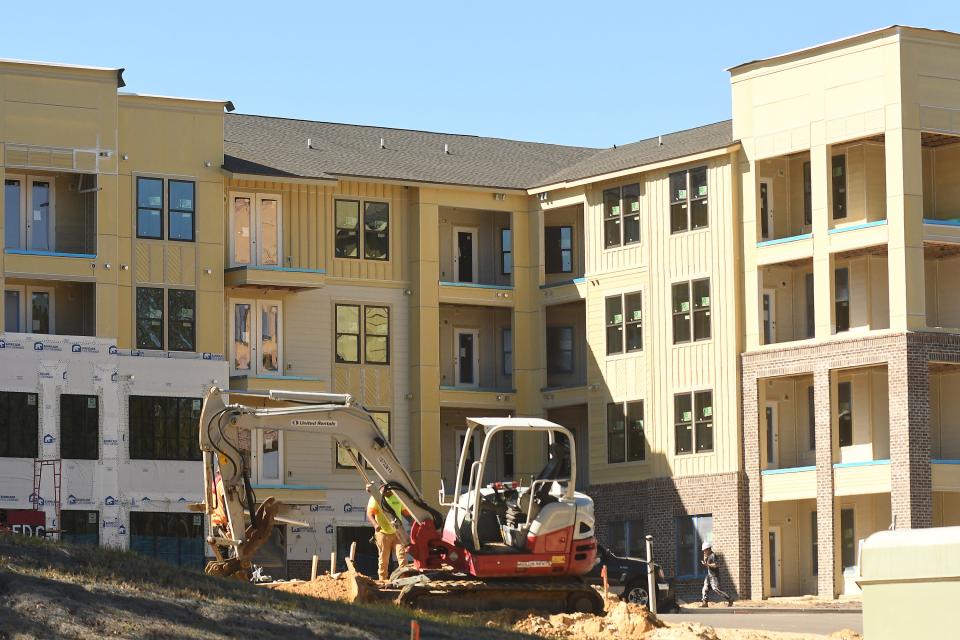
Brunswick is discovered
Sue recalled one of the first steps to the county’s growth occurred in the late 1980s. At the time, Pfizer had proposed building its Southport plant, but the city needed a steady supply of water for the plant.
“So, the county commissioners before me decided they were going to go and put in a water system,” he said. “They couldn’t justify just on what Pfizer would require, so they talked Oak Island at the time into going into the water business, too.”
Those discussions led to the county starting its water system, a well plant on N.C. 211. But not long after it was built, the plant had to be expanded.
“Things were growing, and people started coming in, and we needed water, but that wasn’t producing enough,” Sue said.
The conclusion led to the county expanding its water system. In the mid-1990s, Sue said there was a need for sewer treatment plant to accommodate the growth. Sue, who was then serving as a commissioner, made the motion for the county to establish a regionalized sewer system.
Once water and sewer infrastructure was in place, developers began building housing developments, and people began flooding into the county.
According to the 2000 U.S. Census, Brunswick entered the new millennium with 73,717 people in 30,438 households. Over the next two decades, Brunswick’s population exploded, reaching 107,431 in 2010 and 136,693 in 2020. As of July 1, 2022, the U.S. Census estimated Brunswick County’s population at 153,064.
In an email, Michael Cline, demographer with the N.C. Office of State and Budget Management, explained in-migration, specifically retirement migration, is driving Brunswick’s population growth as well as suburbanization from Wilmington, but on a much smaller scale.
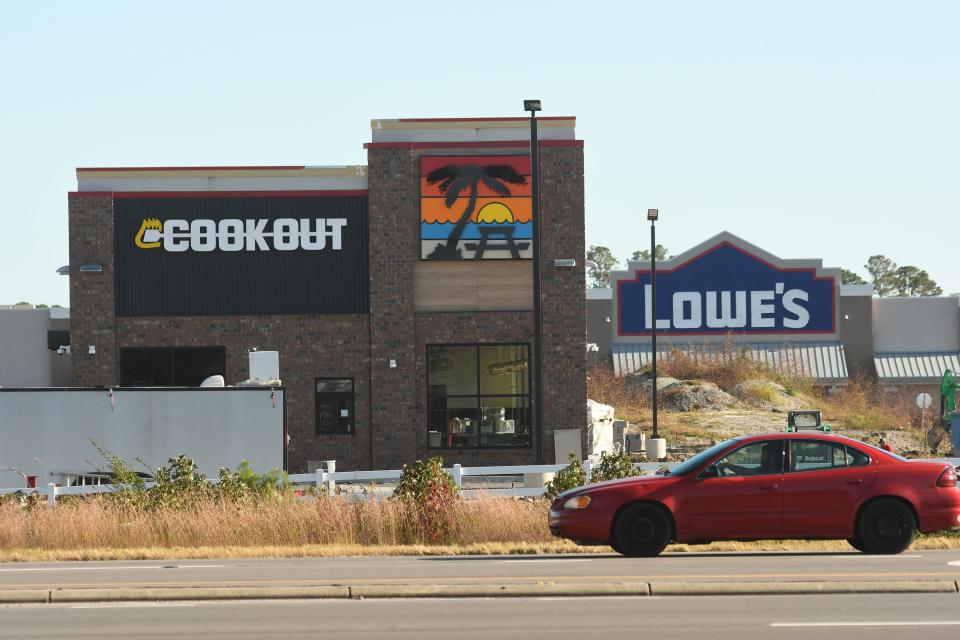
As a result, developers are building new housing projects to meet the demand. As of November, more than 46,000 housing units have been approved and are in various stages of the construction process, and more than 3,700 others have been proposed.
In addition to housing, the growth has also brought more businesses. Recently, several local and national chains -- Lowe's Home Improvement, Hobby Lobby, Biscuitville, and Cook Out -- have announced plans to open new locations in Brunswick County.
The area is also seeing more small businesses.
In 2017, Wendy Brown opened her shop, Mason Dixon, in Shallotte.
"I felt like there was a need for a boutique clothing and home decor at a price point that was affordable for people like me and my friends -- locals," she said.
Brown started as a gift shop and boutique, knowing they could change the format if needed. She admitted getting through the COVID-19 pandemic was a challenge, but the growing crop of loyal, local customers helped her sales continue to grow even during that time.

"We've been blessed that, from a financial standpoint, we've grown year after year, and even during the COVID year, we've been able to beat the previous year's sales," Brown said.
When it comes to her average shopper, Brown said there really isn't one. The store outfits all ages, from birth to senior citizens, and appeals to a broad age range. While most of her shoppers have been around Brunswick County for a while, she does say that about 25 percent mention they have recently moved to the area.
However, she noted that because so many of her shoppers moved here from other places, she is able to order items that appeal to an array of styles and tastes.
"I can do the western look, I can do the beachy look," she explained. "Because we have so many different people from different areas that have moved here and, thankfully, come here."
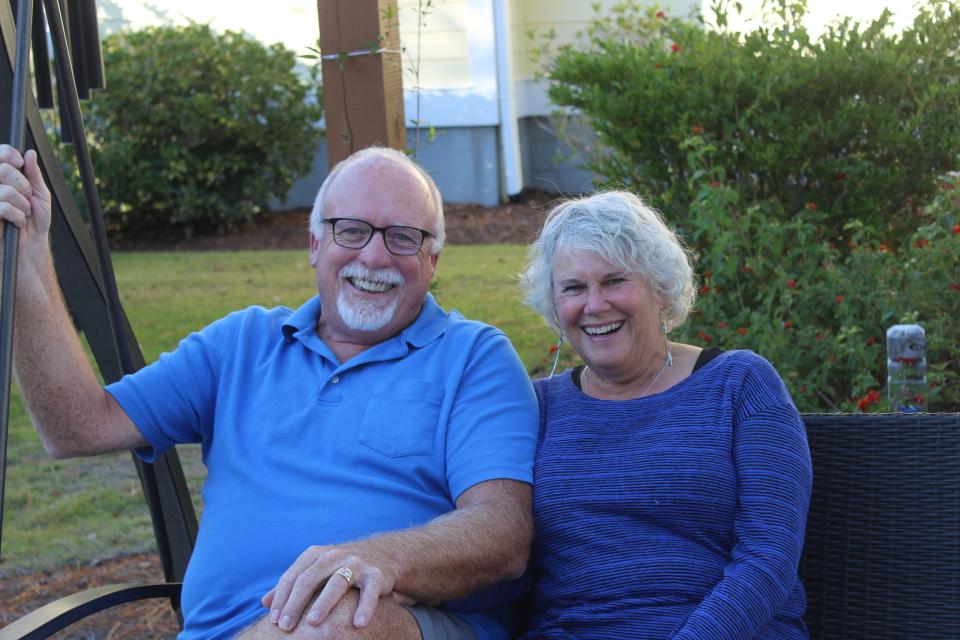
One couple's dream becomes reality
About 12 years ago, Dan and Nancy Barton were on a family vacation with their kids when they stumbled across Southport.
They found the small coastal city by accident as they drove off the ferry and ended up in the Harbor Oaks development. The couple said its quaintness reminded them of small coastal towns in New England.
“It’s so homey,” he said.
Soon, that accidental discovery became a regular trip for their family.
“Almost every year or every other year, we’d come back and visit for a couple of days on our way somewhere else,” Dan explained.
At the time, the couple lived in Washington, D.C. Later they moved to Massachusetts and then Florida before finally landing in St. James in March. Since settling in, both Dan and Nancy say life in Brunswick County is like a dream.
“Every day, we pinch ourselves because we can’t believe we’re actually here,” she said. “We really love the area.”
When choosing their new home, they acknowledge the proximity to the ocean was a big factor.
“She loves the ocean,” Dan said, gesturing to Nancy. “One of her things was, ‘I’ve got to be near a beach,’ and well, there are so many beaches.”
Oak Island is about 15 minutes from the Bartons' home, and several others are within an hour’s drive.
The weather was another factor in their decision to move to Brunswick County. Tired of the frigid winters in Massachusetts and endless sweltering summers in Florida, they believed Brunswick County offered the best of both worlds — one with all four seasons.
“This was a perfect combination,” Nancy said. “I still get to wear some of my winter sweaters. The summer lasts a little longer than it did in Massachusetts and winters are shorter.”
They also love the activities the area offers. The couple owns a motorcycle, and there are lots of places for scenic rides. They enjoy visiting the shops in Southport and taking in the concerts and outdoor movies throughout the summer and fall. Nancy was impressed with the arts scene and the number of art shows, and she and Dan joined the Brunswick Newcomers Club, which offer opportunities to get out and socialize. The couple has even purchased a boat.
“Never had a boat in our life, but here we are — old — and now, we’ve got a boat,” he said. “I’m just learning how to use it.”
Perhaps the most important factor for them has been the sense of community the area offers.
“People are so warm and friendly,” Nancy said.
She recalled at least three times, she has been browsing inside one of the shops in Southport, chuckling at the funny sayings on some dish towels or cards, when other shoppers will strike up a conversation
“We’re all pointing out the funny ones to each other,” she said. “Here you are in a store, and you don’t know anybody, and you still find people to talk to. I love it here.”
While Dan and Nancy have moved eight times over the course of their 21-year marriage, they say they are done moving and their address in Brunswick County will be their final one.
“We feel like we’ve finally found where we want to be,” Nancy said.
“It’s just wonderful, you wake up, and you’ve got great neighbors and a great community here,” Dan said. “You just go downtown Southport, and it’s just like, ‘Oh my God. This ain’t real.’”
“You get the best of all worlds here,” Nancy added.

Could Brunswick outgrow New Hanover?
New Hanover County has also seen tremendous growth over the past two decades — just not at the same rate as Brunswick. In an email, New Hanover County spokesman Alex Riley said the county grew by 11.4 percent from 2010 to 2020 with the 2020 U.S. Census reporting the county’s population at 225,702.
The population is expected to continue growing in both counties with 2050 projections showing Brunswick’s population at 260,121 and New Hanover’s 1.2 times the size of Brunswick at 319,147. Cline pointed out that's less than the difference reflected in the 2020 U.S. Census numbers, which showed New Hanover’s population was 1.5 times larger.
“If the rates of growth for these two counties continue beyond 2050, then Brunswick County could feasibly surpass the population of New Hanover County beyond 2050,” Cline said. “Of course, lots can happen between now and then.”
When it comes to growth, Brunswick — the state’s sixth largest county with nearly 1,000 square miles of area — has much more room to grow than New Hanover, which is the state’s second smallest county with 225 square miles. Currently, estimates show that nearly 85 percent of Brunswick County remains undeveloped.
While there is a considerable amount of undeveloped land, Brunswick County spokeswoman Megan Kascsak pointed out there are many other factors that can affect future long-term growth such as allowable densities, accessibility to water and sewer infrastructure, actual buildable area, building heights, wetlands, floodplains, farming and timbering industry, and conservation lands.
In addition to the environment, population growth can also depend on the people themselves. The state demographer’s projections assume current trends in fertility, mortality, and migration will continue, and changes in those factors could affect the projections. Cline explained Brunswick County’s in-migration of retirees results in natural decrease and fewer births.
Cline said changing those factors would involve diversifying the county’s economy, building an environment and programs to attract younger people while maintaining and building additional infrastructure to attract new retirees.
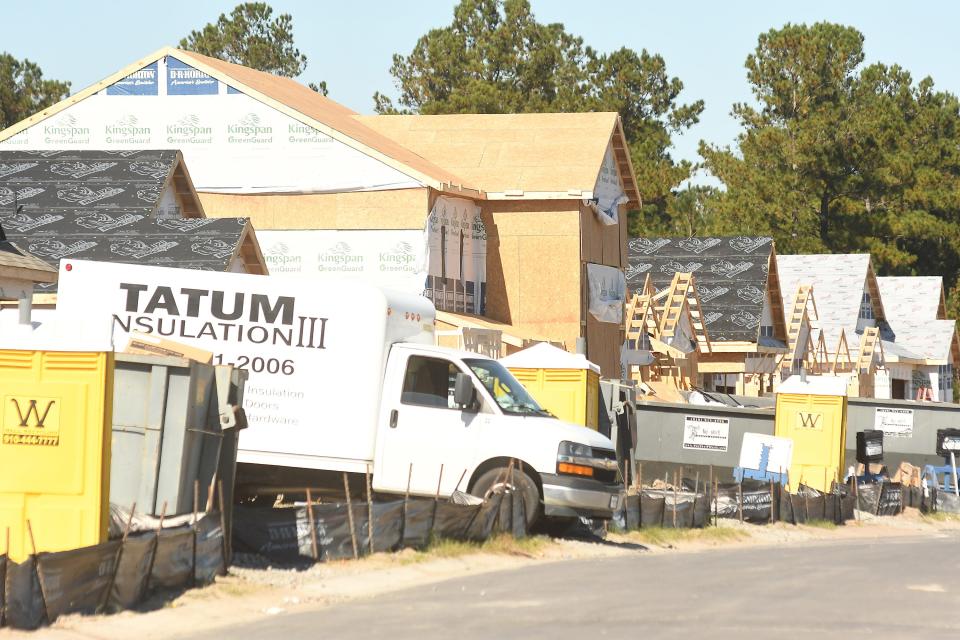
Impacts of growth
The migration of people into Brunswick County has resulted in more than just an increase in the number of housing developments. The growth has also brought more retailers and services to the area, lessening the need for Brunswick’s residents to cross the bridge into Wilmington.
But the boom has brought more traffic and increased demand on the county’s infrastructure. Kascsak said officials are working to address the county’s needs.
“Brunswick County has been aware of the growth happening here and has been planning for a long time on projects and plans to accommodate growth and mitigate its impacts,” she said.
Kascsak noted the county has several water and sewer infrastructure projects either completed or underway, and several more are planned. The county is currently expanding capacity and installing a low-pressure reverse osmosis treatment system at the Northwest Water Treatment Plant, upgrading the transmission main in Shallotte and working with Lower Cape Fear Water and Sewer Authority partners to upgrade the transmission main at the Kings Bluff Water Treatment Plant, upgrading the water treatment plant on N.C. 211, and expanding the Northeast Brunswick Regional Wastewater Treatment Plant.
Planned upgrades include expansions at the Shallotte Wastewater Plant, and Mulberry Branch Water Reclamation, Northeast Brunswick Regional Water Reclamation and West Brunswick Regional Water Reclamation facilities.
“Also, Brunswick County Public Utilities has recently completed a wastewater master plan and is working on completion of a water master plan that will be used to guide future Capital Improvement Plan updates,” she said.
While these infrastructure upgrades come at a significant cost to the county, there are some benefits to a growing population. Cline explained funding for many federal and state programs is allocated based on population or a related factor.
“State aid for street maintenance and sales tax distributions to local governments are the largest allocations of state dollars that incorporate population as a factor, but there are many other programs as well,” he said. “In addition, state agencies would likely shift some of their budget to meet the needs to provide services in growing areas such as Brunswick County.”
When it comes to determining that funding, the U.S. Office of Budget and Management assigns counties to statistical areas. Brunswick County was previously part of the Myrtle Beach Metropolitan Statistical Area, but earlier this year, it rejoined New Hanover and Pender counties in the Wilmington Metropolitan Statistical Area.
Some wonder how that area could change if Brunswick continues its track of exponential growth and one day surpasses New Hanover County’s population. But Cline explained it’s unlikely there would ever be a separate MSA for Brunswick County because the metropolitan statistical areas are designated by urban areas with populations of 50,000 or more. Currently, Brunswick’s most populated city is Leland, which had a population of 22,908 as of the 2020 U.S. Census.
“The two major urban areas in Brunswick County are on the north and south ends – Wilmington and Myrtle Beach-North Myrtle Beach,” Cline said. “Current growth patterns indicate that these areas will continue to expand. I think it more likely that the two MSAs would one day be combined into one major MSA.”

Will it ever stop?
Sitting on Sue’s front porch, you hear only the melodic tunes of the wind chimes. It's hard to imagine less than five miles away, there is bumper-to-bumper traffic on Village Road in Leland and packed shopping center parking lots.
For those who have seen the changes in Brunswick County, adjusting to the growth can be difficult. For the most part, Sue has accepted it but admits he sometimes has “second thoughts.”
“I made the motion to get us in the sewage business, and had we not got in the sewage business, we wouldn’t have had the growth, and sometimes, I think I might have made a mistake,” Sue admits.
But he also acknowledges that once the floodgates have opened, it’s difficult to close them, and the county will never go back to the way it was when he was a child.
“People are going to come, and we’re not going to be able to stop them,” he said. “So, we might as well prepare to receive them.”
STAY CONNECTED: Keep up with the area’s latest Brunswick County news by signing up for the Brunswick Today newsletter and following us on Facebook and Instagram.
This article originally appeared on Wilmington StarNews: Brunswick County growth and development could outpace Wilmington

